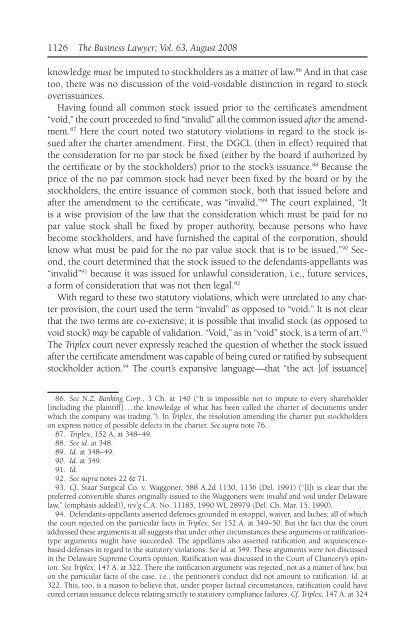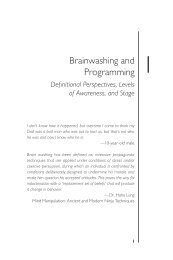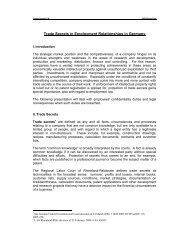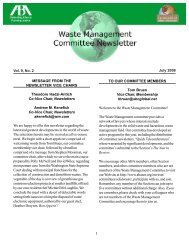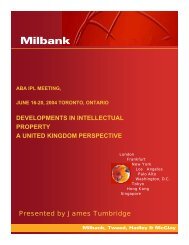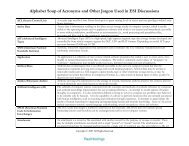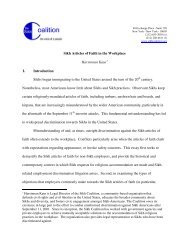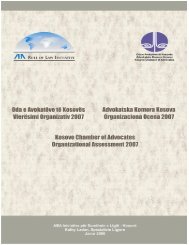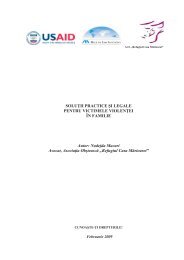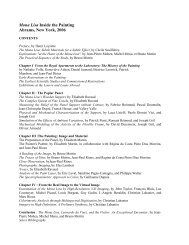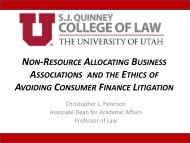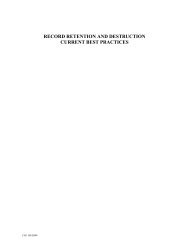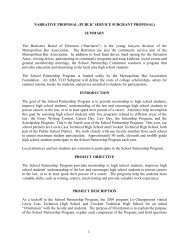Curing Defects in Stock Issuances - American Bar Association
Curing Defects in Stock Issuances - American Bar Association
Curing Defects in Stock Issuances - American Bar Association
Create successful ePaper yourself
Turn your PDF publications into a flip-book with our unique Google optimized e-Paper software.
1126 The Bus<strong>in</strong>ess Lawyer; Vol. 63, August 2008<br />
knowledge must be imputed to stockholders as a matter of law. 86 And <strong>in</strong> that case<br />
too, there was no discussion of the void-voidable dist<strong>in</strong>ction <strong>in</strong> regard to stock<br />
overissuances.<br />
Hav<strong>in</strong>g found all common stock issued prior to the certifi cate’s amendment<br />
“void,” the court proceeded to fi nd “<strong>in</strong>valid” all the common issued after the amendment.<br />
87 Here the court noted two statutory violations <strong>in</strong> regard to the stock issued<br />
after the charter amendment. First, the DGCL (then <strong>in</strong> effect) required that<br />
the consideration for no par stock be fi xed (either by the board if authorized by<br />
the certifi cate or by the stockholders) prior to the stock’s issuance. 88 Because the<br />
price of the no par common stock had never been fi xed by the board or by the<br />
stockholders, the entire issuance of common stock, both that issued before and<br />
after the amendment to the certifi cate, was “<strong>in</strong>valid.” 89 The court expla<strong>in</strong>ed, “It<br />
is a wise provision of the law that the consideration which must be paid for no<br />
par value stock shall be fi xed by proper authority, because persons who have<br />
become stockholders, and have furnished the capital of the corporation, should<br />
know what must be paid for the no par value stock that is to be issued.” 90 Second,<br />
the court determ<strong>in</strong>ed that the stock issued to the defendants-appellants was<br />
“<strong>in</strong>valid” 91 because it was issued for unlawful consideration, i.e., future services,<br />
a form of consideration that was not then legal. 92<br />
With regard to these two statutory violations, which were unrelated to any charter<br />
provision, the court used the term “<strong>in</strong>valid” as opposed to “void.” It is not clear<br />
that the two terms are co-extensive; it is possible that <strong>in</strong>valid stock (as opposed to<br />
void stock) may be capable of validation. “Void,” as <strong>in</strong> “void” stock, is a term of art. 93<br />
The Triplex court never expressly reached the question of whether the stock issued<br />
after the certifi cate amendment was capable of be<strong>in</strong>g cured or ratifi ed by subsequent<br />
stockholder action. 94 The court’s expansive language—that “the act [of issuance]<br />
86. See N.Z. Bank<strong>in</strong>g Corp., 3 Ch. at 140 (“It is impossible not to impute to every shareholder<br />
[<strong>in</strong>clud<strong>in</strong>g the pla<strong>in</strong>tiff ] . . . the knowledge of what has been called the charter of documents under<br />
which the company was trad<strong>in</strong>g.”). In Triplex, the resolution amend<strong>in</strong>g the charter put stockholders<br />
on express notice of possible defects <strong>in</strong> the charter. See supra note 76.<br />
87. Triplex, 152 A. at 348– 49.<br />
88. See id. at 348.<br />
89. Id. at 348– 49.<br />
90. Id. at 349.<br />
91. Id.<br />
92. See supra notes 22 & 71.<br />
93. Cf. Staar Surgical Co. v. Waggoner, 588 A.2d 1130, 1136 (Del. 1991) (“[I]t is clear that the<br />
preferred convertible shares orig<strong>in</strong>ally issued to the Waggoners were <strong>in</strong>valid and void under Delaware<br />
law.” (emphasis added)), rev’g C.A. No. 11185, 1990 WL 28979 (Del. Ch. Mar. 15, 1990).<br />
94. Defendants-appellants asserted defenses grounded <strong>in</strong> estoppel, waiver, and laches; all of which<br />
the court rejected on the particular facts <strong>in</strong> Triplex. See 152 A. at 349–50. But the fact that the court<br />
addressed these arguments at all suggests that under other circumstances these arguments or ratifi cationtype<br />
arguments might have succeeded. The appellants also asserted ratifi cation and acquiescencebased<br />
defenses <strong>in</strong> regard to the statutory violations. See id. at 349. These arguments were not discussed<br />
<strong>in</strong> the Delaware Supreme Court’s op<strong>in</strong>ion. Ratifi cation was discussed <strong>in</strong> the Court of Chancery’s op<strong>in</strong>ion.<br />
See Triplex, 147 A. at 322. There the ratifi cation argument was rejected, not as a matter of law, but<br />
on the particular facts of the case, i.e., the petitioner’s conduct did not amount to ratifi cation. Id. at<br />
322. This, too, is a reason to believe that, under proper factual circumstances, ratifi cation could have<br />
cured certa<strong>in</strong> issuance defects relat<strong>in</strong>g strictly to statutory compliance failures. Cf. Triplex, 147 A. at 324


